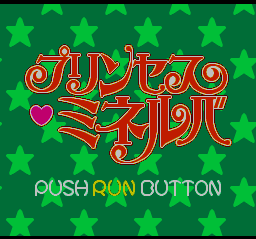The game's production values are high, with a fully-voiced and substantially animated introduction. We're introduced to the various characters and their different fighting styles, and their combat wardrobe which has clearly been selected by a heterosexual male with no regard for field safety:
The story begins as Minerva and her friends are all taking a bath in her luxurious mansion; a threatening note is delivered via arrow, and as luck would have it, nobody even has time to get dressed before absorbing its earth-shattering import:
Of course, I don't speak Japanese, but it's fairly clear from the context that there is an evil band of enemies at large, also all female, and that Minerva and her almond-eyed friends must sally forth and deal with this threat. Fortunately, the enemy leader favors fishnet armor that appears to provide precious little protection:
Past the lengthy intro, we find ourselves in traditional JRPG territory -- it's time to explore the village, talk to the townspeople, and visit the shops to equip our characters with weapons, spells, potions and armor. The shops are individually detailed, and if we have any questions about the game's cast, we see here that all of the armor is designed for female warriors, with schoolgirl uniforms and armor with prominent breast-plating. At least we are spared any "It's fun to shop!" sexism -- these women are ready to take on the world.
The combat takes an innovative but limiting tag-team approach -- because Minerva has so many friends, the group is divided into three three-person parties. The player has no control over which group gets into any given battle, so we have to try to keep them all healthy and properly equipped. This is no mean feat, as mugging enemies doesn't yield many gold pieces, and even the low-level enemies deal quite a bit of damage to our plucky heroes.
Death is expensive -- and if we can't afford resurrection of the party just lost, we have no choice but to load a previous save and try to make better choices. The battle sequences aren't easy -- our parties tend to be poorly balanced, with one fairly decent fighter and two others who are better off in a support role, but I was struggling with the combat menus so take my impressions with a grain of salt.
The CD-based battle music is nothing special, but the graphics are quite nice, with colorful, detailed sprites and detailed, map-appropriate backgrounds. The soundtrack uses chiptunes when necessary to cover loading time or provide a quick transition, with full-blown CD audio through most of the game, although many of the tracks are quite short and become repetitive after a while.
Princess Minerva certainly doesn't shy away from depicting the female body, and it's committed to the art style -- several of the super-deformed chibi-heroes as seen in the battle sequences look rather chubby around the, er, thong areas. The game also doesn't shy away from religion -- this healing, advice-giving nun found in the local church is quite clearly a Christian character, with a traditional habit and a crucifix in her hands:
Of course, her saintly presence is balanced by a traditional bunny-suited barmaid at the local drinking establishment:
Despite the game's rather blatant devotion to fan service, it's more cute than risque, and it's not actually a bad RPG at all. It's a very standard design for its time, but it looks good and plays smoothly, with detailed statistics to track and juggle and a stronger focus on the party than the leader:
And if the American market had had a rating system at the time to
This is a very obscure manga/anime property, but if you're in the market for a cute RPG, you might be able to find a copy for sale here.















so many forgotten games of the past,i think a life is not enough to know them all.
ReplyDelete